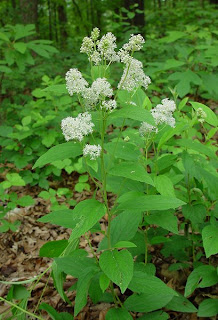PEPPERMINT

Latin Name: Mentha piperita
Alternate Names: Mint, Brandy Mint
Family: LAMIACEAE
Parts Used: Above ground portion.
Properties: Analgesic, Anodyne, Antibacterial, Antiparasitic, Antispasmodic, Antiviral, Aromatic, Carminative, Cholagogue, Diaphoretic, Digestive Tonic, Diuretic, Refrigerant, Stimulant, Stomach Tonic, Tonic, Vasodilator.
Internal Uses: Colds, Colic, Colitis, Cough, Crohn's Disease, Dysmenorrhea, Dyspepsia, Fatigue, Fever, Flatulence, Flu, Gallstones, Halitosis, Headache, Heartburn, Herpes, Hiccups, Indigestion, Irritable Bowel, Migraine, Morning Sickness, Nausea, Stomachache, Stress
Internal Applications: Tea, Tincture, Capsules, Syrup, Lozenges.
Peppermint is a stronger antiparasitic and antiviral than Spearmint. In general, Spearmint is considered a weaker medicinal than Peppermint. It is hypothesized that Peppermint benefits irritable bowels by inhibiting the hypercontractility of the smooth muscles of the intestines.
Peppermint is a stronger antiparasitic and antiviral than Spearmint. In general, Spearmint is considered a weaker medicinal than Peppermint. It is hypothesized that Peppermint benefits irritable bowels by inhibiting the hypercontractility of the smooth muscles of the intestines.
Topical Uses: Arthritis, Burns, Chest Congestion, Chickenpox, Cramps, Fever, Inflammation, Insect Bites, Insect Repellent, Itchy Skin, Measles, Morning Sickness, Muscle Soreness, Nausea, Neuralgia, Pain, Rheumatism, Scabies, Shock, Sinus Congestion, Toothache
Topical Applications: Essential oil is added to massage oils for chest congestion, pain and fever as it is cooling. Essential oil inhaled for sinus congestion, shock and nausea. Used to flavor toothpaste, mouthwash. Use as a bath herb to help one to feel cool and refreshed, as well as to treat bug bites, itchy skin, chicken pox and measles. Essential oil is used to scent soaps, repel mosquitoes and scabies. Use as a cool compress for joint inflammation, neuralgia and rheumatism.
Culinary uses: Spearmint is a better choice for culinary arts than Peppermint. Use fresh leaves as a liner for cake pans. Add either mint to yogurt, dishes, fruit salad, vegetable salad, hummus, split pea soup or tabouli salad. Use mint tea to dilute fruit juices or to make ice cubes. Mint jellies, candies, liqueurs. Mint improves the flavors of other medicines.
Energetics: Pungent, Cool, Dry.
Chemical Constituents: Essential oil (menthol, menthone, methyl acetate, limonene, pulegone), tannins, flavonoids, choline potassium.
Contraindications: Considered very safe and can be used by even the sickest of people. Plant Mint in your gardens where you don't mind it spreading as it has a tendency to take over.
Comments: This description applies to both Peppermint and Spearmint. Mint is one of the most ancient of all medicinal herbs. Mints tend to hybridize easily. Peppermint has long dark green leaves with a thick spike of flowers. Its peppery taste caused people to name it Peppermint. Spearmint, has a narrower spike of flowers and more wrinkled looking leaves. Spearmint's name is derived from Spire-Mint, as the flowers grow in the shape of a spire. In Mythology, Minthe was a lover of Pluto. His jealous wife Prosperine turned Minthe into a Peppermint plant. Ancient Athenians would rub the leaves of mint on their arms to improve their endurance.

